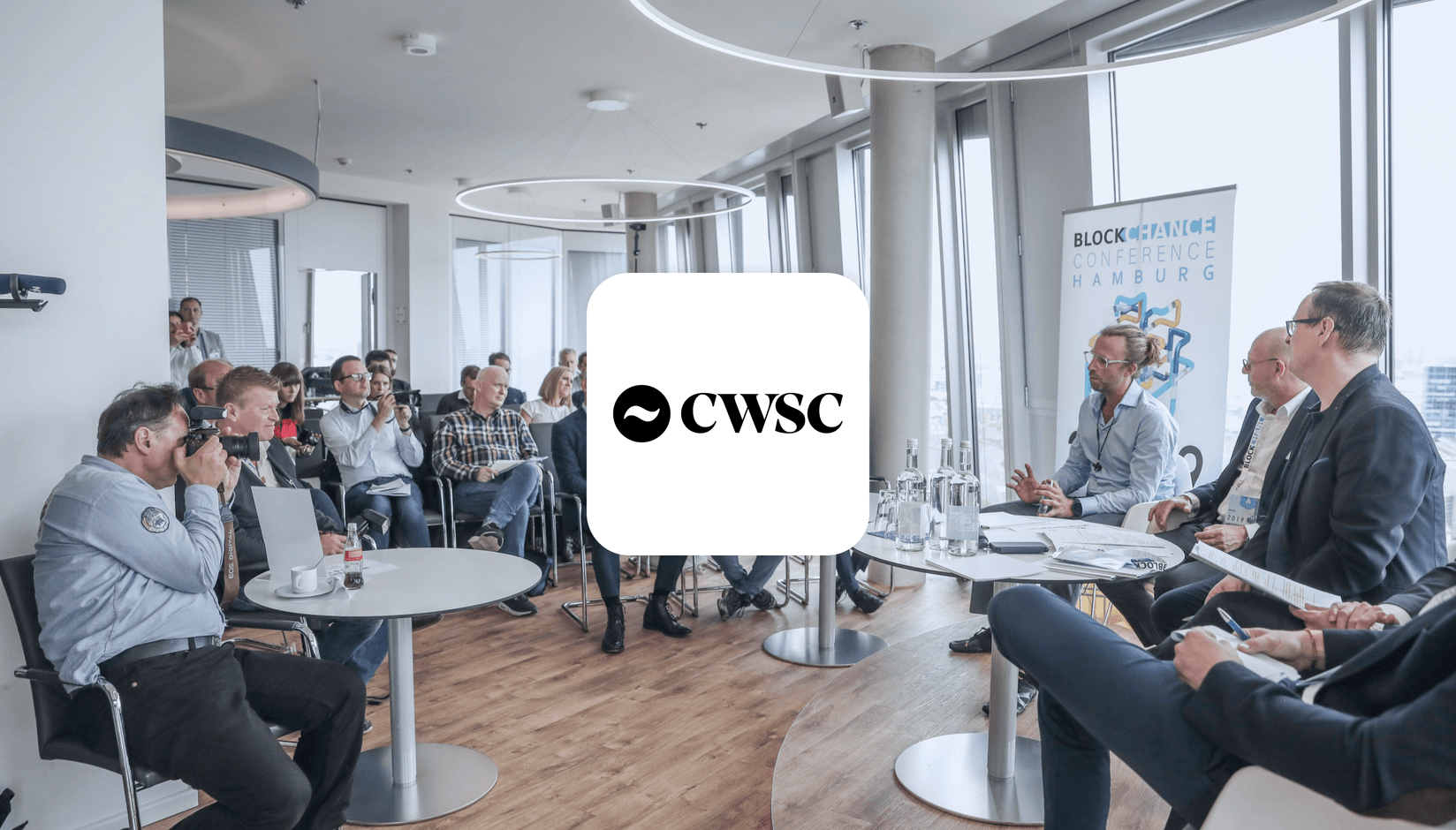- Features
- Solutions
- Pricing
- Resources
- Contact
- Book a demo

Table of Contents
- Trend #1—New Ways Coworking Spaces Bring Happiness
- Trend #2—Scientific Approach to Space Design
- Trend #3—Balance Between Boundaries and Team Spirit
- Trend #4—Sleep Pods and Restful Retreats
- Trend #5—Promoting a Coworking Space as a Better Home Office
- Trend #6—Observing the Behavioral Patterns of Coworking Members
- Trend #7—Growth of Makerspaces Regardless of the Challenges
- Trend #8—Different Approaches to Sustainability
- Trend #9—Creating a Supportive Environment for Startups
- Trend #10—Social Support in Coworking Spaces
- Trend #11—Using Chatbots for a Better Experience
- Trend #12—Tracking Occupancy Patterns
- Trend #13—Find Your Specific Professional Audience
- Trend #14—Coworking Space Botanical Gardens
- Trend #15—Workation Retreats
- Conclusions
As a rule, most of the conversations about coworking spaces usually revolve around similar topics. We know that providing a comfy space and building a strong community is important, but we wanted to take things to the next level. That's why we dug into over 70 scientific papers from the last 3-4 years, looking for insights from other industries and sciences. All of these publications have a strong methodology and a typical peer-to-peer review methodology.
Our research is totally practical, and we're thrilled to be sharing these fact-based findings with you and we hope you'll dive into the references to learn even more.
Let’s start!
Trend #1—New Ways Coworking Spaces Bring Happiness
Scientific articles over the past few years explore the trend of how working in coworking spaces contributes to the happiness of its members. Turns out, coworking spaces are great at boosting satisfaction. This is a powerful differentiator for spaces that want to appeal to company owners.
Here’s what researchers define as the main contributors to the happiness of members of the coworking spaces.

1. Safe and healthy work environment
- Invest in ergonomic equipment like adjustable desks, quality chairs, and monitor stands to promote better posture.
- Regularly assess the availability and condition of equipment to ensure members' comfort and health.
2. Work-life balance
- Create designated quiet zones for focused work and ensure a balance between shared spaces and private areas.
- Implement flexible opening hours to accommodate various work cultures while maintaining a structured environment.
3. Social significance of work and work culture
- Encourage a diverse and inclusive work culture that respects differing values and lifestyles.
- Organize events that foster community engagement and social responsibility to align with your space's ethos.
4. Integration into the work community
- Design the layout to promote interaction; provide communal areas and collaboration spaces.
- Train hosts to facilitate integration through curated events and by welcoming newcomers.
5. Applying and enhancing skills
- Offer skill-building workshops and training sessions to support professional development.
- Encourage members to share expertise and network and consider mentorship programs within your space.
By implementing these actions and following the advice provided, you can create a thriving and supportive environment that attracts members, enhances their experience, and aligns with the evolving needs of today's professionals.
The literature also highlights the positive relationship between a cooperative atmosphere and user happiness, emphasizing the role of collaboration, mutual support, and resource-sharing in creating a thriving coworking community. Also, there’s an emergent trend of job crafting, where individuals actively shape their work experiences.
Trend #2—Scientific Approach to Space Design
A lot about design is subjective. But lately, there has been literature that aims to explain and quantify key terms in layout design. You can combine different approaches and see them as variables that you can increase or decrease.
For example, have you considered how much ambiance your space offers to its members? Or what is the proximity of workplaces, and how does it influence overall satisfaction?

Well, you can do it now. To start, let's break down each of the terms mentioned in the text and explain their significance in the context of coworking spaces:
1. Ambiance
- Definition: Ambiance refers to the overall atmosphere or mood created by the physical environment. It encompasses elements such as lighting, color schemes, furniture, and the general look and feel of a space.
- Opportunities: Creating an inspiring and comfortable ambiance in coworking spaces can enhance the users' experience and productivity. It influences their motivation, creativity, and overall satisfaction with the space. Ambiance plays a crucial role in attracting and retaining users.
2. Proximity
Definition: Proximity refers to the physical closeness or distance between individuals within a space.
Proximity in coworking spaces affects the level of interaction and collaboration among users. Open-plan offices with close physical proximity encourage spontaneous communication and collaboration among users from diverse backgrounds. It can foster a sense of community and networking opportunities. Low-priority spaces cater to members who want privacy and prefer concentrated work.
3. Connectivity
Definition: Connectivity in coworking spaces refers to the establishment of links or connections between individuals and groups through both physical elements (such as spatial layout) and digital technologies.
Connectivity enables users to interact and collaborate effectively. It includes physical connectivity through shared facilities and infrastructure, as well as virtual connectivity through digital platforms like Slack or your coworking space app. Enhanced connectivity leads to better communication, knowledge sharing, and collaboration among users and organizations.
Generate recurring revenue and offer exceptional customer experience at your shared or coworking space
4. Privacy
Definition: Privacy involves protecting individuals' control over the accessibility of their information and setting boundaries between personal and shared spaces.
Providing varying degrees of privacy options in coworking spaces is essential to cater to users with different needs. It ensures that users can choose spaces where they feel comfortable and can control their work environment. Privacy considerations include visual and auditory privacy, especially in open-plan settings.
5. Architecture of innovation
Definition: Architecture of innovation refers to the design and layout of coworking spaces that stimulate creativity, idea generation, and problem-solving among users.
Coworking spaces designed with an architecture of innovation can inspire users to think creatively and collaborate across boundaries. It involves creating an environment that supports personalization, offers a balance between collaborative and private spaces, and provides resources for users to realize their innovative ideas.
How can I optimize these variables?
1. Ambiance optimization
1.1. Spatial architecture
- Unique spatial layouts: Design the coworking space with unique spatial layouts that incorporate multifaceted orientations. For example, you can create different working situations within the same space, accommodating both individual and collaborative work.
- Bright lights and saturated colors: Use bright lights and saturated color schemes to create an inspirational ambiance.
- Stylized furniture: Furnish the coworking space with stylized and comfortable furniture. Consider incorporating cozy chairs and sofas.
1.2. Flexibility
- User personalization: Allow users to rearrange furniture and personalize their workspace to a certain extent. Provide options for users to adjust their workspace layout.
2. Proximity management
2.1. Physical proximity
- Open-plan offices: Design open-plan offices that promote physical proximity among users from different professional backgrounds. Encourage collaboration and interaction by providing shared workspaces with fewer physical barriers.
- Flexible layouts: Use flexible furniture arrangements and partitions to adapt proximity based on user needs. Allows users to change proximity from high (collaboration) to low (concentration).
2.2. Behavioral management
- Guidelines and etiquette: Establish clear guidelines and etiquette for users to maintain an appropriate level of noise and disturbance in crowded areas. Create designated quiet zones for users requiring high concentration.
3. Connectivity enhancement
3.1. Physical connectivity
- Strategic placement: Strategically place shared facilities and infrastructure to encourage spontaneous collaboration. For instance, ensure common areas and socialization spaces are easily accessible and conducive to interaction.
3.2. Digital connectivity
- Online platforms: Integrate online platforms like Slack and Microsoft Teams, or coworking management tools like Spacebring to facilitate virtual connectivity among users. Encourage users to maintain digital profiles for easy identification of complementary skills and expertise.
Discover how hundreds of spaces worldwide unlock success and grow better with Spacebring
4. Privacy management
4.1. Privacy options
- Workspace variety: Offer various workspace options, including open-plan workstations, private offices, and meeting rooms. Allow users to choose spaces that align with their privacy needs, as seen in the text's examples of coworking spaces with private offices.
- Visual privacy: Use dividers or soft boundaries to partition open spaces and provide visual privacy without completely isolating users.
4.2. Noise management
- Soundproofing: Implement soundproofing measures in open-plan areas to minimize noise disturbances. Designate specific areas for phone calls and discussions to reduce disruptions.
5. Architecture of innovation
5.1. Personalization
- Assigned and unassigned desks: Offer both assigned and unassigned desks to cater to users' preferences. Allow users to personalize their assigned desks, creating a sense of ownership, similar to the text's mention of personalization options.
5.2. Balance
- Collaborative and private spaces: Create a balance between collaborative and private spaces. Design collaborative areas for brainstorming and idea sharing while providing private areas for focused work or team meetings.
5.3. Realization support
- Support structures: Include support structures like hardware labs for users to develop prototypes and turn ideas into reality, as highlighted in the text's reference to coworking spaces with hardware labs.
These specific recommendations align with the examples and details provided in the text, ensuring a more tailored approach to optimizing coworking space layouts for socio-material routines.
Trend #3—Balance Between Boundaries and Team Spirit
To build a strong community, just fostering a sense of community is not enough. Recent literature discusses the importance of respect, privacy, boundaries, and informed consent of every member for building a truly comfortable community.
According to these articles, here’s what you should focus on.
1. Building a sense of community
Significance: A strong sense of community is a key attraction for coworking spaces. It fosters collaboration, networking, and member satisfaction.
Implementation:
- Create opportunities for members to interact and get to know each other, such as through communal events, workshops, or social gatherings.
- Encourage open communication and cooperation among members.
- Establish a community manager or point of contact to address member needs and conflicts.
2. Boundaries
Setting boundaries between members and non-members helps define the community, making members feel like they belong.

Implementation:
- Clearly communicate the criteria for becoming a member.
- Define basic rules for respectful behavior and shared space etiquette.
- Promote a sense of exclusivity and safety within the community.
3. Emotional safety
Significance: Emotional safety allows members to open up, share their needs, and develop intimacy, leading to stronger connections.
Implementation:
- Foster a culture of inclusivity and respect within the community.
- Consider appointing a contact person or community mediator to address emotional safety concerns.
- Make emotional safety a central theme in community guidelines.
4. Belonging and identification
Feeling like they belong and identify with the community makes members more committed and engaged.
- Promote shared values, attitudes, and perspectives through community events and discussions.
- Encourage social interaction by designing workspaces that facilitate communication.
- Highlight and maintain values that promote belonging, such as helpfulness among members.
5. Personal investment
- When members invest personally in the community, it strengthens their commitment.
Implementation:
- Establish an incentive system that rewards active participation and engagement.
- Actively motivate less-involved members to become more socially integrated.
- Select members based on their social skills, compatibility, and alignment with community goals.
6. Common symbol system
Developing a common symbol system reinforces the community's identity and visibility. This is not just about branding but even about emojis, colors, and other communication symbols.
Implementation:
- Choose unique symbols associated with the coworking space.
- Promote a sense of equality among members by avoiding hierarchy-based symbolism.
- Design workspaces consistently to reflect shared values and identity.
7. Influence
Members' influence on the community and vice versa helps align attitudes and values.
Implementation:
- Assess the balance of influence within the community for each member.
- Keep negative influences away from the community.
- Use rules and norms to promote positive influence and trust among members.
8. Integration and fulfillment of needs
Meeting the needs of members and integrating them into the community enhances comfort and openness.
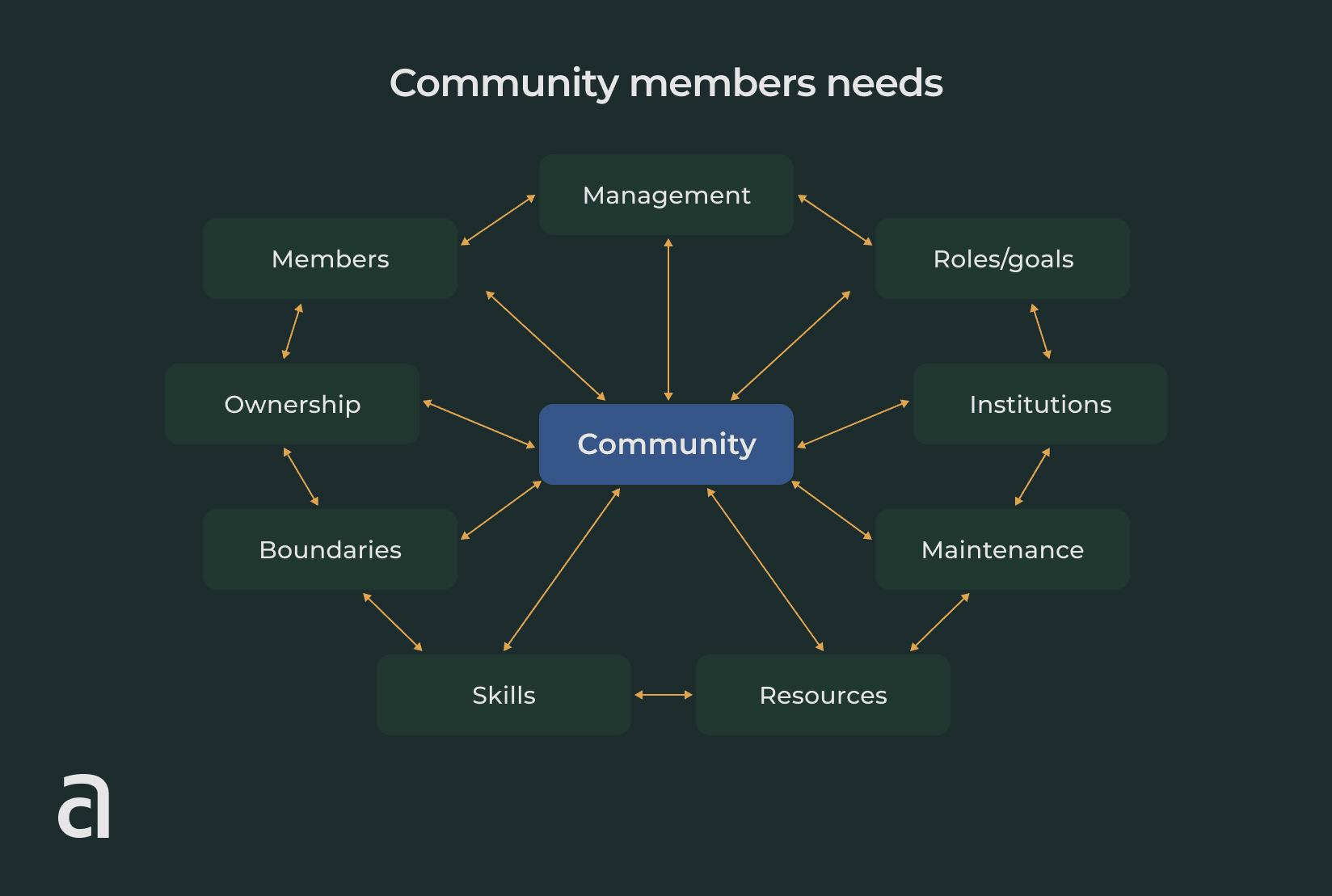
Implementation:
- Assess the tolerance level and integration speed within the community.
- Act as a community manager to counteract anti-integrative behavior.
- Facilitate regular community meetings and team-building events to promote integration.
9. Emotional connection
Building emotional connections over time strengthens the sense of community.
Implementation:
- Organize events and create spaces for members to get to know each other better.
- Encourage ongoing engagement and long-term orientation within the community.
- Be mindful of potential conflicts that intense emotional attachment can create.
10. Trust
Trust is essential both among members and between members and the space provider.
Implementation:
- Build trust by adhering to community rules and being transparent about pricing and policies.
- Foster trust among members through open communication and community-building activities.
- Address conflicts and violations promptly to maintain trust.
11. Competitive stimulation
Competition can either harm or promote the sense of community, depending on how it's managed.
Implementation:
- Consider including competitors in the coworking space, especially if they can collaborate against external competitors.
- Set clear rules and encourage sportsmanship among members to handle competition positively.
- Be prepared to address conflicts that may arise due to competition within the community.
12. Conflict resolution
Conflicts are inevitable, and having mechanisms to resolve them is crucial to maintaining a healthy community.
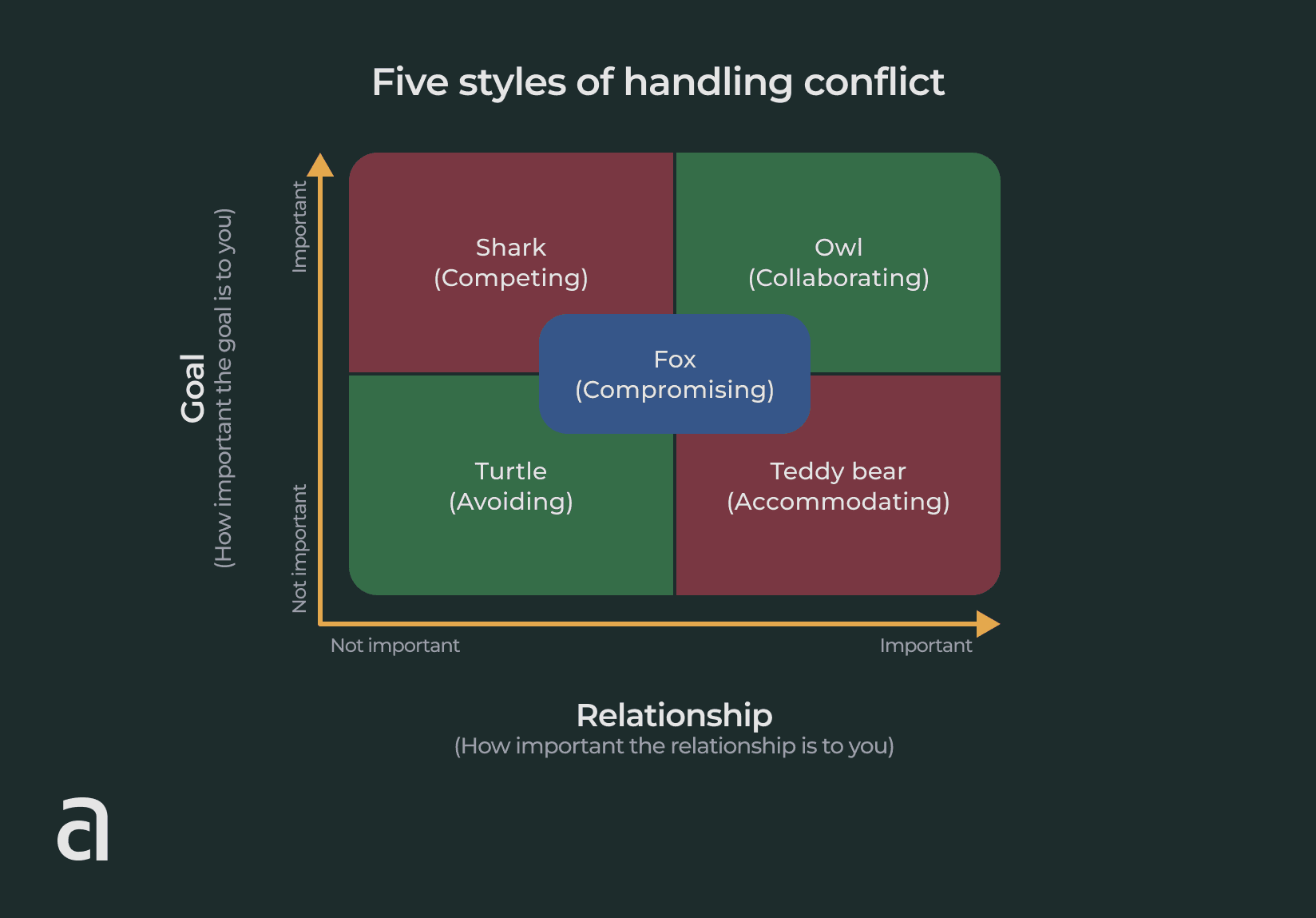
Implementation:
- Assess conflicts to determine the nature and interdependence of the parties involved.
- Choose appropriate conflict resolution mechanisms, such as mediation or community-wide discussions.
- Prevent conflicts from escalating and potentially splitting the community.
Certainly, let's provide a more detailed explanation for each of the building blocks, values, and factors discussed in the text regarding creating a sense of community in coworking spaces.
Trend #4—Sleep Pods and Restful Retreats
While coworking spaces have long been associated with productivity, collaboration, and networking, a trend that is not frequently discussed but is gaining momentum is the integration of sleep pods and restful retreat areas within these shared work environments.

In today's fast-paced and often overworked professional landscape, employees and entrepreneurs are recognizing the importance of rest and rejuvenation. Coworking spaces are evolving to meet this need by offering designated areas where individuals can take power naps or simply unwind during a hectic workday.
Here's why this trend is on the rise:
- Enhanced productivity: Short naps have been proven to boost alertness, creativity, and overall productivity. Coworking spaces that provide sleep pods allow members to recharge quickly, leading to more focused and efficient work.
- Reduced stress: The modern work environment can be stressful. Having a tranquil retreat area within a coworking space provides a sanctuary for individuals to relax, meditate, or practice mindfulness, reducing stress levels.
- Improved well-being: Mental health and well-being are gaining prominence in discussions about workplace culture. Coworking spaces that prioritize restful retreats demonstrate a commitment to the holistic wellness of their members.
- Competitive advantage: Offering sleep pods and retreat spaces sets a coworking space apart in a competitive market. It attracts professionals who value work-life balance and self-care.
- Networking opportunities: Ironically, rest areas can foster networking and collaboration. When individuals take breaks in these spaces, they often engage in casual conversations that can lead to meaningful connections.
- Extended hours: Coworking spaces with sleep pods can operate 24/7, accommodating members with diverse schedules, including night owls and those working across time zones.
While sleep pods and restful retreats may not be the first thing that comes to mind when you think of coworking spaces, they represent an innovative response to the evolving needs of today's workforce. As professionals increasingly seek a balance between work and well-being, expect to see more coworking spaces incorporating these features into their offerings.
Trend #5—Promoting a Coworking Space as a Better Home Office
There’s research that aims to explore and understand the concept of stress and strain in the context of the workplace. This concept originated from the work of Rohmert and is centered on the idea that stress and strain experienced by individuals in a work environment are influenced by a combination of external factors known as stressors and individual factors.
Stressors encompass a wide range of elements within the work system, including task characteristics, equipment, physical and social factors. The research emphasizes that stress is not a uniform experience and varies based on individual factors like constitution, abilities, and health status.
Prolonged exposure to stressors or high-intensity stress can lead to negative consequences, including health issues and performance-related problems. The impact of different work environments, such as the home office and coworking spaces, on stress and strain levels.
This is something coworking space owners can and absolutely should leverage to their advantage.
Objective vs. subjective
There’s a distinction between objective stressors (external stimuli) and psychophysiological stress reactions (individual responses). It underscores the importance of separating these concepts both linguistically and conceptually.
Positive and negative effects of telework
The positive effects of telework are increased autonomy, better work-life balance, and reduced stress and exhaustion.
However, it also has negative aspects, including social isolation and work intensification.
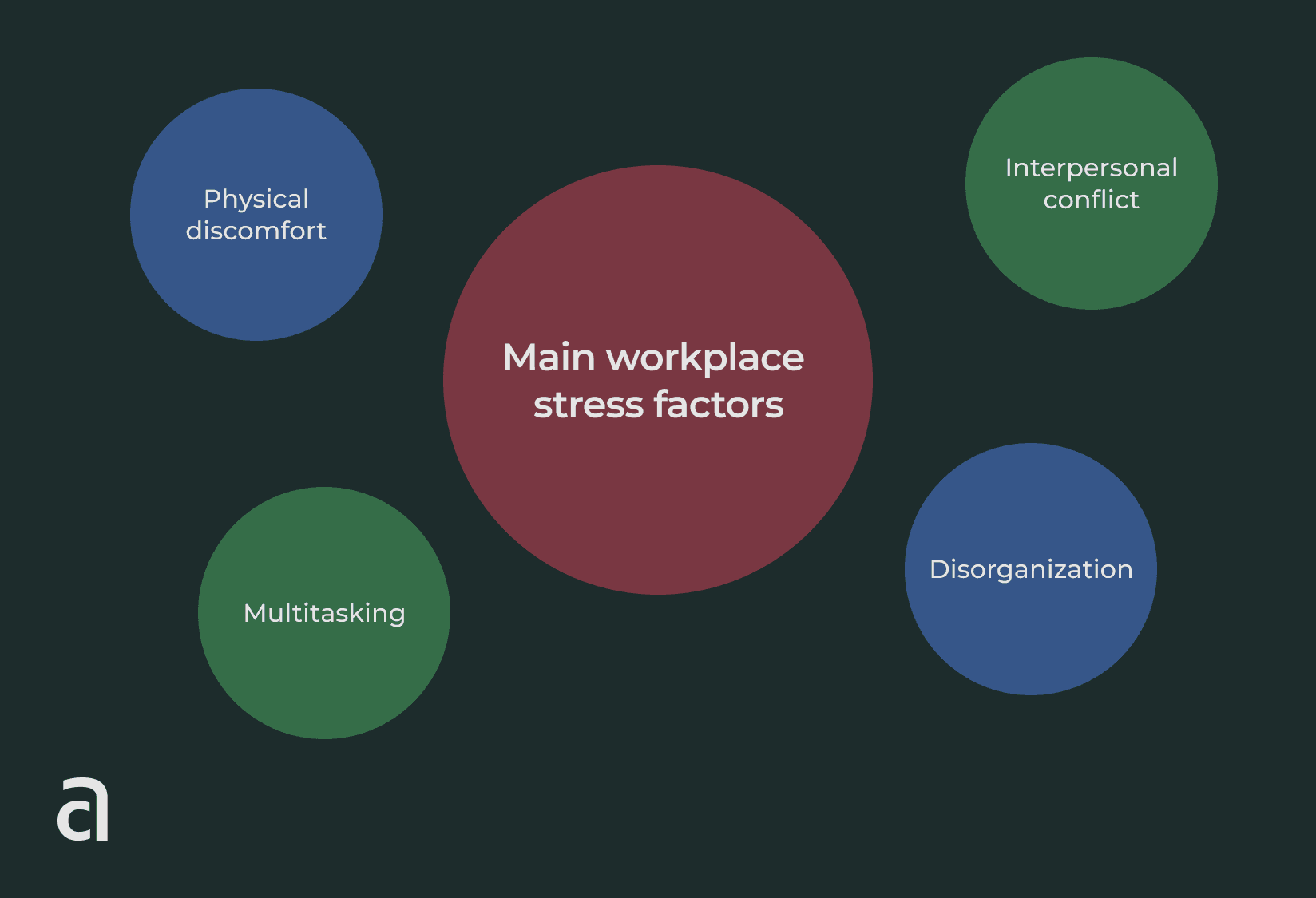
Key findings
- Stress is not a uniform experience for all employees but is rather shaped by individual factors such as one's constitution, abilities, and health status.
- Two individuals in the same work environment may experience vastly different levels of stress and strain. In essence, stress can be viewed as the response or reaction of an individual to these objective stressors.
- Prolonged exposure to stressors or experiencing them at a high intensity can lead to various dysfunctions, diseases, or performance-related consequences. It's important to note that stressors themselves are not to be completely avoided, as certain combinations of stressors can result in an optimal level of strain, which is believed to have positive effects on both health and performance.
- Approximately half of the participants reported good health status, with an overall high level of satisfaction with their coworking spaces. Psychosomatic complaints were relatively low, and satisfaction with coworking spaces was consistently positive.
- Coworking spaces were seen as advantageous for concentration, social interaction, and the separation of work and private life. Participants favored coworking spaces over home offices in terms of overall job satisfaction. However, they did not perceive coworking spaces as more ergonomic or conducive to health-related behaviors like eating and physical activity.
Insights to take away
Coworking spaces excel in terms of social interaction and work-life balance. The social environment and support network provided by coworking spaces were highly valued by users. Surprisingly, many coworkers did not find the noise levels or privacy to be worse in coworking spaces than in home offices.
For coworking space operators, there are practical implications that can enhance the coworking experience. These include offering skill development workshops, emphasizing the importance of ergonomic office furniture, and creating appealing workspaces that consider environmental factors such as noise levels. These efforts can not only attract more users but also contribute to the overall satisfaction and well-being of those who choose to work in coworking spaces.
Trend #6—Observing the Behavioral Patterns of Coworking Members
There’s been a trend of exploring the role of the community of coworking spaces, seeing them as gatherings of mindful people as opposed to rooms with desks and chairs. However, according to some authors, coworking spaces can even borrow patterns from organizations.
It turns out, that just like members of organizations have clear routines, so do coworking members have their patterns. Observing those can help owners satisfy their clients better. For example, you can focus on three aspects.
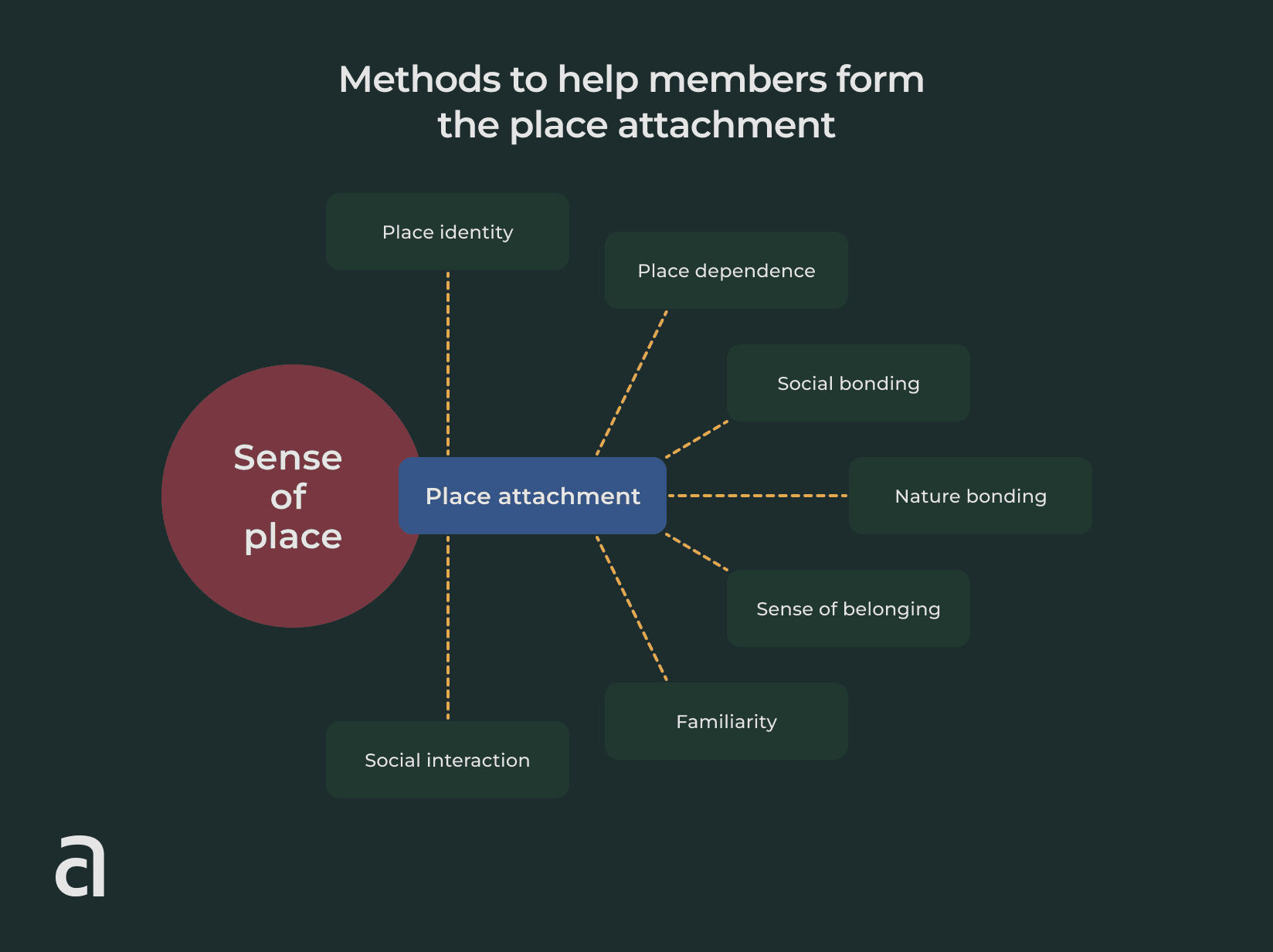
Rituals
Rituals are central to understanding the vibrant social fabric of coworking spaces. In the context of the study, rituals are defined as patterns of interaction that provide templates for making sense of social reality. These rituals serve as crucial building blocks for community cohesion.
- Collective breakfast: Regular breakfasts together gather a diverse group of coworkers, including formal members, students, clients, and potential investors. Participants sit around a communal table with a simple breakfast buffet, fostering an atmosphere of inclusivity and openness. The breakfast also nurtures relationships, serving as a platform for introductions, small talk, and project discussions.
- Informality vs formality: What sets coworking rituals apart is the balance between formality and informality. While some events are organized and advertised by betahaus management, the essence of these rituals is the informal contributions and interactions of the members. This informal atmosphere allows participants to share personal stories, challenges, and experiences, creating a welcoming environment for constructive critique and camaraderie.
- Testing ground: Beyond social connections, rituals also provide a platform for testing new ideas and projects. Coworkers can present their initiatives to a supportive and sympathetic audience before taking them to market. This aspect highlights the value of rituals as a means of both personal growth and professional development.
Routines
Routines offer a structured framework within coworking spaces, helping individuals navigate the sometimes tricky boundaries between work and personal life.
Co-discipline
Co-discipline emerges as a unique concept within coworking spaces, signifying a shared sense of order and accountability:
- Spatial and temporal boundaries: One of the key challenges for independent workers is managing the overlap between work and leisure in their lives. Coworking spaces can stand out by providing a solution by establishing clear spatial and temporal boundaries. Coworkers typically arrive at work around the same time each day (between 9 and 10 a.m.) and often leave at a consistent time (around 6:30 p.m.). This routine helps individuals maintain a healthier work-life balance.
- Work rhythm: Coworking spaces help coworkers structure their workdays into manageable chunks. From morning work sessions to lunch breaks and coffee breaks, these routines allow for the efficient organization of tasks. The shared work rhythm fosters connections and social interactions among coworkers, enhancing the sense of belonging and camaraderie.
- Voluntary discipline: Interestingly, these routines are not imposed but voluntarily embraced by coworkers. The routines enable self-discipline and focus, creating an environment where individuals can maximize their productivity. While maintaining a structure, coworkers still have the flexibility to choose when and how they work.
- Motivation and productivity: The presence of fellow coworkers serves as a motivating factor. It helps individuals maintain concentration and productivity levels that might be challenging to achieve when working alone. Knowing that others are working around them inspires coworkers to stay on task.
- Social control: This co-discipline is not about external pressure but arises naturally from shared routines. It's a subtle form of social control where coworkers encourage each other to maintain discipline and stay committed to their work.
- Individual choice: Importantly, this form of discipline is viewed as a matter of individual choice. Coworkers voluntarily participate in these shared routines and accept the co-discipline that comes with it. This underscores the importance of personal agency and commitment within coworking communities.
In conclusion, coworking spaces are not just shared workplaces; they are thriving ecosystems where rituals, routines, and co-discipline play pivotal roles in fostering a sense of community, productivity, and well-being among independent workers.
Understanding these concepts can shed light on how coworking spaces effectively balance structure and flexibility to meet the diverse needs of their members. As remote and independent work continues to shape the future of employment, coworking spaces offer valuable insights into creating supportive and collaborative work environments.
Trend #7—Growth of Makerspaces Regardless of the Challenges

Makerspaces, these intriguing hubs of creativity and innovation, have been popping up all over the place. They're often seen as breeding grounds for entrepreneurs and inventors, where anyone can tinker with tools and turn their ideas into reality. But is this hype around makerspaces living up to reality?
Recent research suggests that while makerspaces have made significant strides in building a sense of community and offering access to specialized tools, they might not be the hotbeds of entrepreneurial activity that we expected.
Great expectations, few results
Makerspaces were envisioned as places where entrepreneurs would flock to bring their groundbreaking ideas to life. However, interviews with makerspace managers reveal a disconnect between expectations and reality. Many makerspaces are still waiting for that next big thing to emerge from their facilities.
A lack of entrepreneurial drive
Some makerspace managers have expressed frustration over the perceived lack of entrepreneurial drive in their communities. They wonder why more members aren't jumping at the chance to develop groundbreaking products. It's not that makerspaces aren't trying to help; they're just not seeing the level of innovation they hoped for.
Risk aversion: a barrier to innovation
In some cases, it's not a lack of entrepreneurial spirit but rather a reluctance to take risks that's holding makerspaces back. Some communities seem hesitant to pursue new ventures, which can be a significant hurdle for smaller regions hoping to foster innovation.
Pivoting for success
Makerspaces have recognized these challenges and are adapting their strategies. They are positioning themselves as early-stage entrepreneurial hubs, focusing on ideation and brainstorming. By doing so, they aim to spark a culture of innovation and increase their community's willingness to take the plunge into entrepreneurship.
From hobbies to businesses
Many makerspaces are now helping members turn their hobbies into small lifestyle businesses. While these businesses may not achieve massive scalability, they still play a crucial role in nurturing the local entrepreneurial ecosystem.
Incubators vs. coworking spaces vs. makerspaces
It's important to understand the differences between incubators, coworking spaces, and makerspaces. Incubators primarily support scalable projects and provide extensive mentoring. Coworking spaces offer communal workspace for businesses but not necessarily manufacturing equipment. Makerspaces are open to the public and provide access to manufacturing equipment, making them unique in their focus on hands-on creativity.
Small business growth
Makerspaces are also contributing to small business growth by offering office space and access to specialized tools. By providing coworking services, they help entrepreneurs launch businesses with lower overhead costs. This shared workspace adds an extra layer of community, fostering collaboration and diversity among professionals.
Workforce training
In addition to business support, makerspaces fill the skills gap by offering training in manufacturing and technology. As traditional shop classes disappear from schools, makerspaces step in to provide hands-on experience with machinery. While formal certification programs may be on the horizon, makerspaces currently offer aspiring professionals an opportunity to gain valuable skills.
Worker retention
Perhaps one of the most unexpected benefits of makerspaces is their role in retaining skilled workers in communities. By creating vibrant and creative communities, makerspaces become magnets for talent, encouraging professionals to stick around and contribute to local industries.
So, makerspaces are evolving to meet the challenges of fostering innovation and entrepreneurship. While they may not have produced the next big thing just yet, they are undoubtedly shaping the future of work, business, and skills development in our communities.
Trend #8—Different Approaches to Sustainability
Recent research has unveiled that coworking spaces are not a monolith when it comes to sustainability. Rather, they comprise four distinct perspectives, each with its own unique focus and priorities. Let's explore these perspectives and what they mean for sustainability.
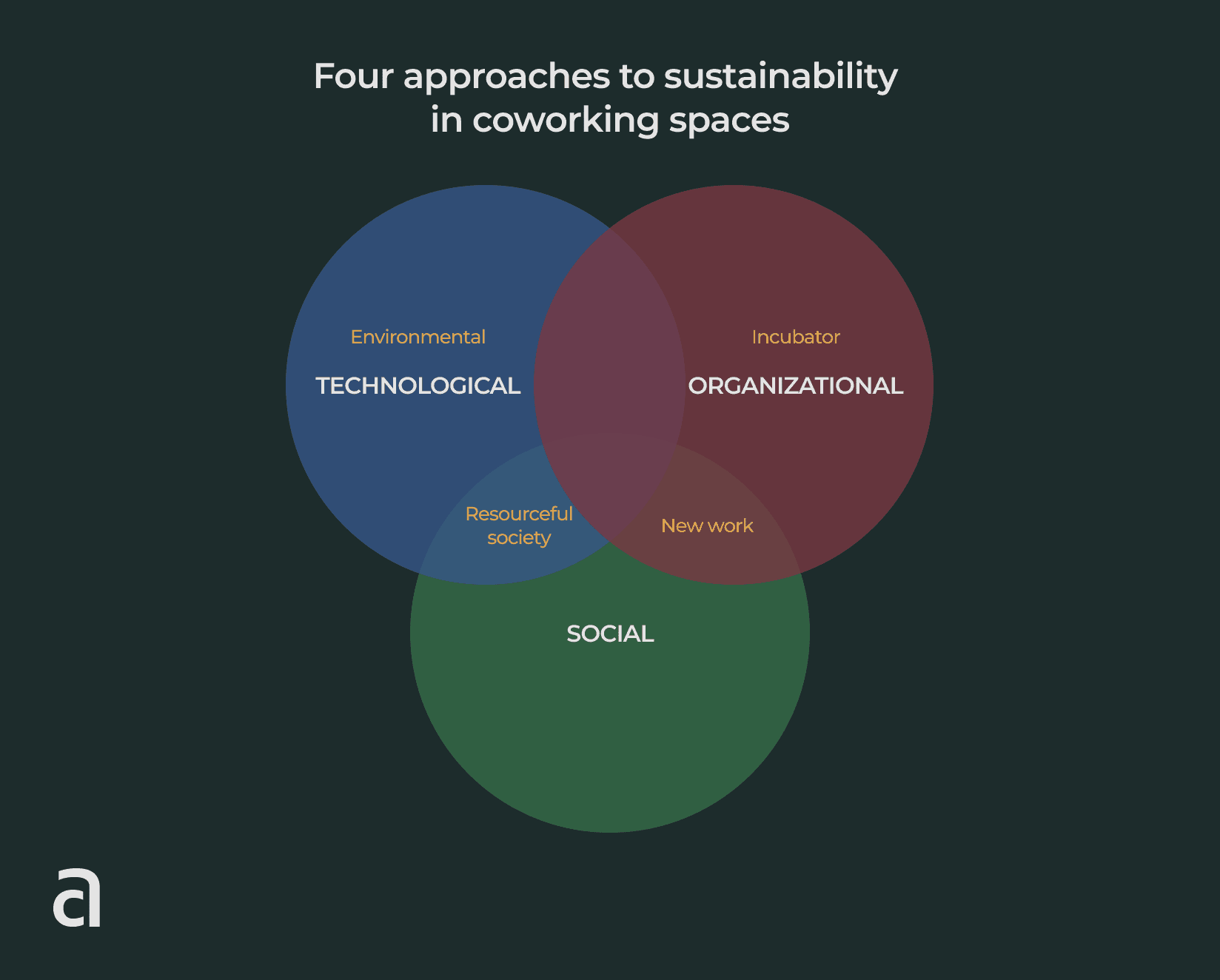
1. "New Work" perspective
This perspective, shared by eight participants, places a strong emphasis on community and collaboration as central to sustainability. For these individuals, coworking spaces should foster a sense of belonging and encourage members to work together, ultimately building a sustainable entrepreneurial ecosystem. This perspective champions flexible access, open office cultures, and shared resources.
2. "Resourceful Society" perspective
The Resourceful Society perspective prioritizes optimizing resources with an environmental focus. Members believe in using renewable energy, repurposing existing buildings, and minimizing waste as essential sustainability practices. This perspective aligns with a broader vision of creating value from waste and maximizing material and energy efficiency.
3. "Incubator" perspective
The "Incubator" perspective emphasizes community, long-term sustainability, and supporting member businesses. For them, coworking spaces should be more than shared offices; they should nurture and incubate startups and small businesses. Long-term missions and a focus on people over profit are central to this perspective.
4. "Environmental" perspective
The "Environmental" perspective is strongly focused on environmental sustainability. Their top priorities include recycling, composting, efficient lighting, and reducing carbon footprints. They believe that coworking spaces should lead by example in sustainable practices.
By acknowledging and embracing these diverse perspectives, coworking spaces can evolve into true engines of sustainability, accommodating members with varied sustainability needs and contributing to a more environmentally conscious and socially responsible future.
Trend #9—Creating a Supportive Environment for Startups
A recent study has delved deep into how coworking spaces, particularly accelerators, play a pivotal role in enhancing the innovation performance of these fledgling businesses. Here, we uncover the significant findings and their implications for startup owners and the broader entrepreneurial ecosystem.
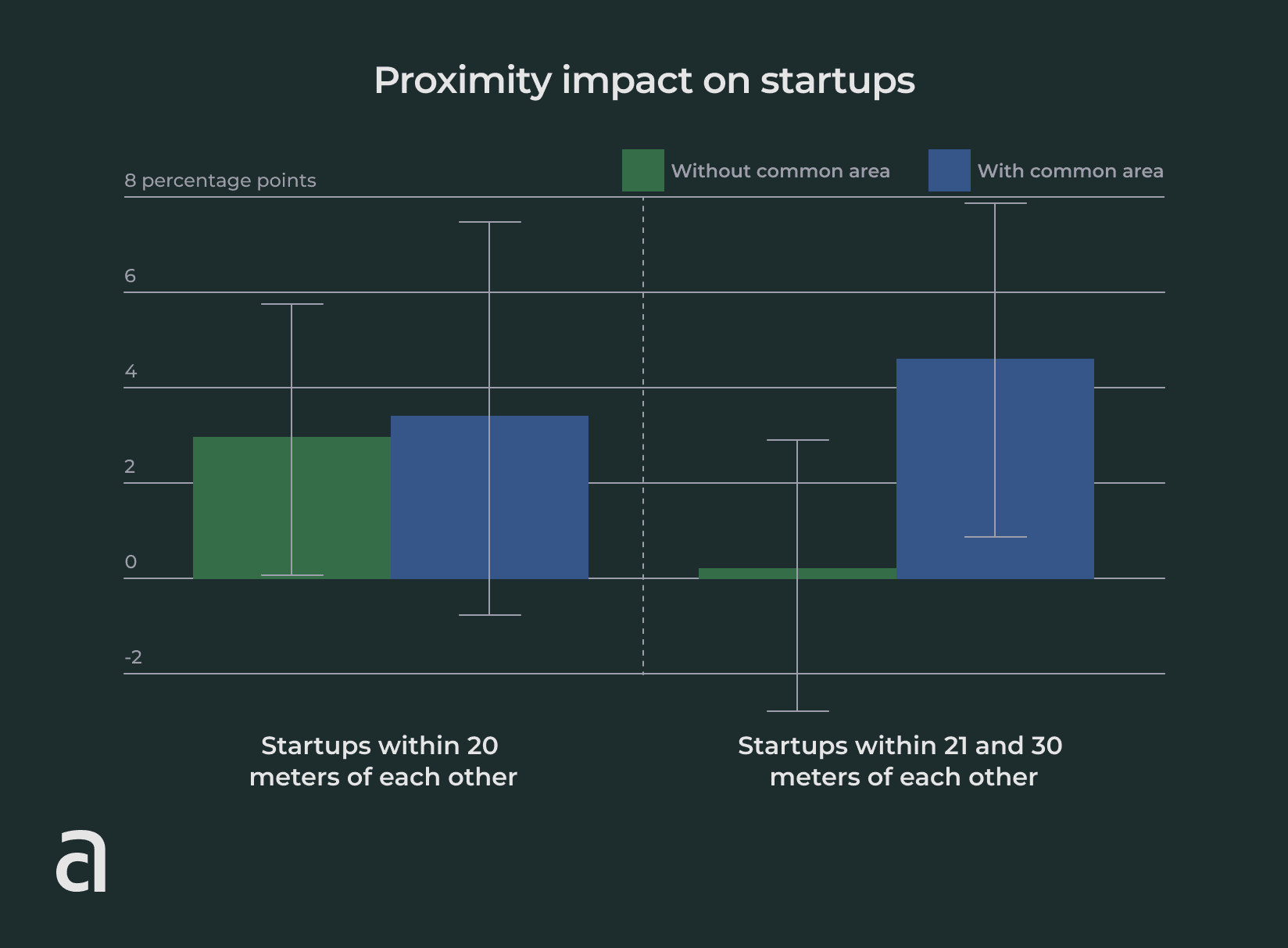
Startups situated in coworking spaces can gain valuable insights from neighboring startups. According to a study titled "Working in Close Proximity: Knowledge Spillovers and Social Interactions" (NBER Working Paper 30120), researchers observed that the transfer of knowledge is most effective among startup employees who engage in social interactions but are involved in somewhat divergent businesses.
The team of researchers focused on one of the top five tech-centered coworking venues in the country. Between August 2014 and January 2017, 251 startups were randomly allocated offices within a multi-level building. The study revealed that startups positioned within a 20-meter radius were considerably more inclined to incorporate the same emerging web technologies—a measure for knowledge spillovers—compared to those situated at a greater distance. Interestingly, startups housed on the same level but spaced further apart did not exhibit a higher likelihood of benefiting from knowledge transfer compared to those on separate floors.
The Importance of external knowledge
Startups face a unique challenge - they often begin their journeys with limited resources and knowledge. This inherent knowledge deficit can significantly elevate the risk of failure. To bridge this gap, they must tap into external sources of learning effectively.
Let's dissect the key findings and explore how coworking spaces can contribute to the success of startups by assuming some functions as accelerators:
1. Competitors fuel incremental innovation
Within the accelerator environment, other startups operating in the same cohorts, often referred to as "competitors," serve as a valuable source of external knowledge.
Interaction with competitors encourages strategies rooted in imitation, which correlates positively with incremental innovation. The physical proximity of these startups further facilitates knowledge exchange.
How coworking spaces help: Coworking spaces like accelerators provide a fertile ground for startups to coexist, collaborate, and share insights. The physical proximity within these spaces encourages spontaneous interactions and knowledge sharing among startup teams. This environment fosters a culture of continuous learning and incremental innovation.
2. Educators and incremental innovation
Educators, in the context of accelerators, primarily enhance incremental innovation. Interactions with educators boost a startup's social and human capital. This, in turn, positively influences innovation performance. Educators help startups filter out irrelevant information. Also, these interactions elevate the professional skills and expertise of startup teams, further enhancing innovation.
How coworking spaces help: Coworking spaces provide a structured framework for startups to engage with educators. They offer workshops, mentorship programs, and expert-led sessions where startups can gain insights, acquire new skills, and expand their social capital.
3. Investors drive radical innovation
Investors, including venture capitalists and business angels, emerge as crucial catalysts for radical innovation. Their contributions extend beyond financial support to providing valuable advice and knowledge. This knowledge transfer enhances startup innovation. These investors possess specialization in specific technological fields, making their knowledge particularly effective for startups. Furthermore, professional investments influence innovation performance by shaping managerial aspirations.
How coworking spaces help: Coworking spaces, especially accelerators, should work towards becoming hubs where startups can pitch their ideas to potential investors. This direct access to investors within the coworking environment streamlines the process of securing both financial support and valuable insights.
Trend #10—Social Support in Coworking Spaces
Beyond mere physical amenities, coworking spaces thrive when they facilitate emotional, informational, and instrumental support among their members.
This is not just about helping people connect but also about encouraging help on a volunteering basis as well as allowing productive give-and-take relationships.

Emotional support
- Trust and empathy: Coworkers create a trusting environment where they can openly discuss their challenges and fears without judgment. For example, a web designer might confide in a fellow coworker about the stress of meeting a tight client deadline.
- Camaraderie: Regular social events, such as Friday evening gatherings, provide opportunities for coworkers to unwind, share personal experiences, and offer emotional support. Sharing stories of both successes and failures is a great way to strengthen bonds..
- Motivation and inspiration: Successful coworkers often become role models for others. For instance, a coworker who has launched a successful startup might share their journey, motivating others to take risks and pursue their entrepreneurial goals.
Informational support
- Knowledge sharing: Coworkers share their expertise and knowledge freely. For example, a marketing specialist might offer insights into the latest digital marketing trends during a casual conversation.
- Skill enhancement: Workshops and events within the coworking space provide opportunities to learn new skills. A graphic designer might attend a coworker-hosted workshop on advanced Photoshop techniques.
- Access to resources: Coworkers often recommend valuable resources, such as online courses or industry-specific books. A software developer might suggest a coworker join a private Slack group dedicated to discussing programming languages.
Instrumental support
- Task assistance: Coworkers frequently help each other with specific tasks. For instance, a writer might proofread a fellow coworker's blog post before publication.
- Collaborative projects: Coworkers engage in collaborative projects, combining their skills to accomplish larger tasks. A web developer and a content creator might collaborate on building a website for a shared client.
- Bartering services: Coworkers exchange services, creating a mutually beneficial arrangement. An accountant might provide financial advice to a fellow coworker in exchange for design services for their website.
- Trading time and expertise: Members frequently offer their time and expertise for the betterment of the community. For example, a coworker with legal expertise might provide guidance on data protection regulations during a clinic session.
- Supportive community projects: Coworking spaces often engage in community projects. Members might collectively develop an educational program for local students, contributing their skills and time.
Understanding and harnessing the power of emotional, informational, and instrumental support is crucial for coworking space owners and operators. The success of both individual businesses and the coworking space itself hinges on the ability to leverage social support, making these spaces more than a place to work—it's where dreams are nurtured, businesses flourish, and lifelong connections are forged.
Trend #11—Using Chatbots for a Better Experience
In today's fast-paced work landscape, coworking spaces have emerged as hubs of innovation and collaboration, providing professionals with dynamic environments to thrive. Beyond shared desks and meeting rooms, these spaces are now incorporating cutting-edge technologies like chatbots to enhance the coworking experience. As coworking space owners seek to leverage the advantages of chatbots, it's essential to understand both their benefits and potential challenges.
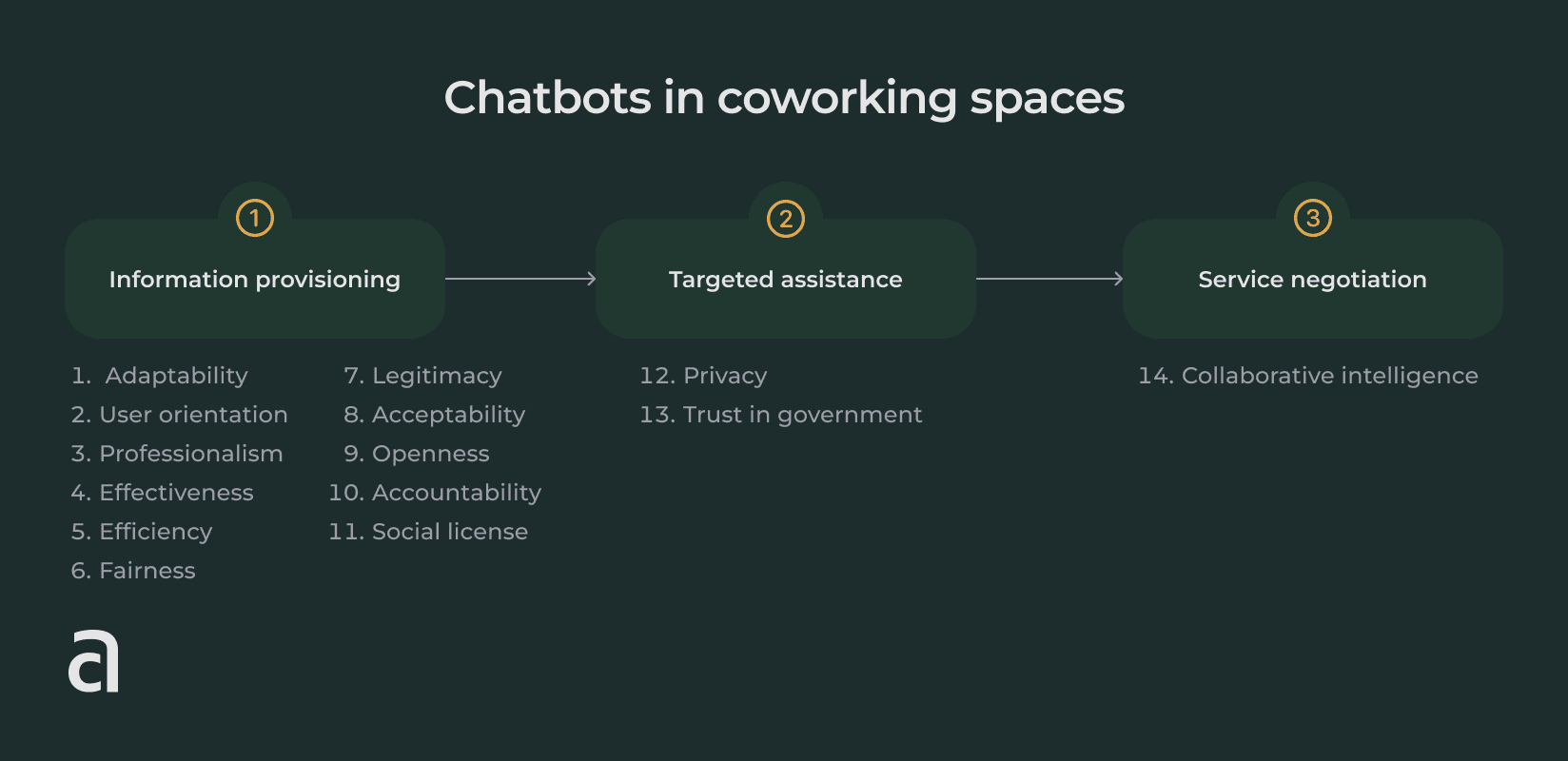
Unlocking benefits
- Enhanced efficiency: Chatbots can streamline administrative tasks, such as scheduling meeting rooms, managing access, and handling inquiries. This efficiency allows coworking space owners to focus on delivering exceptional services rather than getting bogged down by routine tasks.
- Improved customer service: Chatbots provide round-the-clock support, ensuring that coworkers' queries and concerns are addressed promptly.
- Community building: Chatbots can facilitate connections among coworkers. By suggesting relevant events, introducing coworkers with shared interests, or even organizing social activities, chatbots contribute to building a vibrant community within the workspace.
- Data-driven insights: Chatbots can gather valuable data on coworker preferences, behaviors, and needs. Coworking space owners can leverage this data to tailor their offerings, improve member experiences, and make informed business decisions.
Navigating challenges
- Privacy concerns: While chatbots can enhance security through features like access control, privacy concerns may arise. It's crucial for coworking space owners to ensure that data is handled securely and transparently, addressing members' privacy apprehensions.
- Integration complexity: Implementing chatbots into existing systems can be a complex process. Coworking space owners should carefully select chatbot solutions that seamlessly integrate with their management software and member platforms.
- Cost considerations: Developing and maintaining chatbots can incur expenses. Owners must weigh these costs against the benefits they bring and ensure a cost-effective strategy.
- User adoption: Encouraging coworkers to embrace chatbots may require time and effort. Training and onboarding programs may be necessary to ensure that members maximize the potential of these digital assistants.
- Technology limitations: Chatbots are not infallible. They may struggle with complex or highly specialized inquiries. Coworking space owners should establish clear channels for handling such cases to maintain member satisfaction.
By carefully selecting chatbot solutions that align with the unique needs of their coworking spaces and proactively managing the challenges, owners can harness the full potential of chatbots. The result? A coworking environment that not only meets members' expectations but also exceeds them, ensuring continued growth and success in the dynamic world of flexible workspaces.
Trend #12—Tracking Occupancy Patterns

Tracking occupancy helps you provide real-time information on desk and table availability and optimize your space. Source
Coworking spaces have evolved into dynamic hubs for modern professionals. They offer flexibility, collaboration, and innovation. However, to make these spaces truly effective, you need to understand how they are used. A recent case study provides valuable insights into optimizing coworking spaces based on occupancy patterns.
For example, at a BuildSys '22 conference, researchers reported analyzed data collected from occupancy sensors within coworking spaces. These patterns offer essential lessons for coworking space owners.
Reasons to track your members’ seating patterns
- Resource allocation: Understanding daily and weekly occupancy trends can help owners allocate resources more efficiently. For example, scheduling additional staff during peak hours can enhance member experiences.
- Flexible seating: With insights into peak times and seat preferences, coworking spaces can optimize their seating arrangements. This might involve offering more flexible seating options or adjusting layouts based on seasonal variations.
- Membership plans: Armed with occupancy data, coworking spaces can design membership plans that cater to different needs. They can offer flexible pricing based on peak or off-peak hours, ensuring cost-effectiveness for both members and owners.
- Events and workshops: Knowing when coworking spaces are most crowded allows for better event planning. Owners can schedule workshops, networking events, or member meetups during periods of higher occupancy to encourage participation.
- Member experience: By aligning staff availability with peak hours, coworking spaces can enhance member experiences. More attentive customer service, quicker issue resolution, and personalized assistance can lead to higher member satisfaction.
Time series forecasting
With time series forecasting, coworking space owners become able to predict future occupancy levels. This offers practical implications.
- Resource planning: Accurate predictions enable coworking spaces to plan for the future. They can adjust resources, such as cleaning schedules and refreshments, based on projected occupancy.
- Staffing: Efficient staff scheduling ensures that coworking spaces are adequately staffed during busy periods, avoiding overstaffing during quieter times.
- Space optimization: By forecasting seat demand, coworking spaces can maximize space utilization, avoiding overcrowding or underutilization.
Trend #13—Find Your Specific Professional Audience
One emerging trend in the coworking industry that is not often talked about is the creation of specialized coworking spaces designed to cater to professionals within a specific industry. Unlike traditional coworking environments that are open to freelancers, entrepreneurs, and professionals from various fields, these specialized spaces aim to create a more focused community that shares common professional goals, language, and challenges.
For instance, there are coworking spaces exclusively for writers, complete with a library, literary events, and writing workshops. In the tech sector, we might see coworking spaces equipped with advanced hardware and software for coding, app development, or data science.
There are also coworking spaces that cater to artists, offering studio space, galleries, and material shops within the facility. The healthcare sector is not far behind, with coworking spaces that include private consulting rooms and shared medical equipment for independent healthcare providers.
This trend allows for more targeted networking, collaboration, and sharing of industry-specific knowledge, offering a tailored work environment that can help professionals within that industry thrive.
Examples of coworking specialization include
- The Farm SoHo: Aimed at fostering a community of agricultural tech startups, this space offers an ecosystem where agribusiness and technology can intersect.
- IndieBio: This is a coworking lab space designed for biohackers and biotech startups, complete with lab equipment and mentoring services.
- WeWork Food Labs: Targeted toward food startups, this coworking space provides not only desks but also test kitchens and pantry space.
- TechShop: More of a workshop than a traditional office space, this coworking area is focused on makers, providing machinery like 3D printers, laser cutters, and woodworking tools.
- Paragraph: Designed for writers, this coworking space offers quiet areas, a library, and a community of writers to interact with.
- Piloto 151: This is a fintech-focused coworking space in Puerto Rico, designed to cater to the specific needs of startups in the financial technology sector.
- Core Innovation Hub: Focused on construction and architecture professionals, this space offers large-format printers, drafting tables, and specialized software.
- The Hatchery: An Agra-Food focused coworking space where food entrepreneurs can find a commercial kitchen along with traditional office spaces to run their business operations.
- The Yard: Tailored for legal professionals, The Yard offers not just workspaces but also easy access to legal libraries and databases.
- Health Wildcatters: A coworking space focused on healthcare startups, offering facilities like small-scale medical labs and consulting rooms.
- Reaktor: This Helsinki-based coworking space is aimed at students and offers coding classes, hackathons, and free desks to help students get their startups off the ground.
Trend #14—Coworking Space Botanical Gardens
In a bid to merge the concepts of productivity and serenity, a new trend is emerging—Coworking Space Botanical Gardens. These innovative coworking environments are designed as lush, green oases within urban landscapes, where professionals can work amidst a thriving botanical paradise.

Plants and green corners increase productivity and well-being. Source
Key features of coworking space botanical gardens
- Biophilic design integration: These coworking spaces prioritize biophilic design principles, incorporating abundant greenery, natural materials, and even water features directly into the workspace.
- Work amongst flora and fauna: Members have the opportunity to work surrounded by diverse plant species and the soothing sounds of birdsong. It's an environment that fosters creativity and reduces stress.
- Seasonal flexibility: The botanical gardens are adaptable to the seasons, offering different floral displays throughout the year. Members can experience the changing beauty of nature as they work.
- Open-air workstations: Coworking Space Botanical Gardens offer open-air workstations within the garden, complete with shaded areas and ergonomic seating.
- Garden meeting rooms: Instead of traditional meeting rooms, these spaces have garden-themed meeting spaces nestled within the greenery, providing a unique and refreshing backdrop for discussions.
- Inspiration corners: Special corners of the garden are designed for reflection and inspiration, featuring sculptures, quiet seating areas, and reading nooks.
- Wellness Workshops: Regular wellness workshops like yoga and meditation are conducted in the gardens, taking advantage of the tranquil environment for enhanced relaxation.
- Plant care workshops: Members can participate in workshops on plant care and gardening, promoting a deeper connection with the natural surroundings.
- Botanical networking: Unique networking events are organized, such as garden tours and plant exchange programs, fostering a sense of community among members.
- Eco-friendly practices: botanic-focused spaces often follow sustainable and eco-friendly practices, including rainwater harvesting, organic gardening, and composting.
This trend reimagines the traditional coworking experience by immersing professionals in a captivating botanical setting. It offers a harmonious blend of work and nature, transforming the workday into a rejuvenating and inspiring experience. Coworking Space Botanical Gardens represent a novel approach to fostering well-being, creativity, and environmental consciousness among professionals.
Trend #15—Workation Retreats
In response to the evolving needs of professionals seeking a balanced lifestyle, coworking spaces are now offering "Workation Retreats." This trend combines remote work with rejuvenating getaways, catering to individuals looking to escape the daily grind while remaining productive.
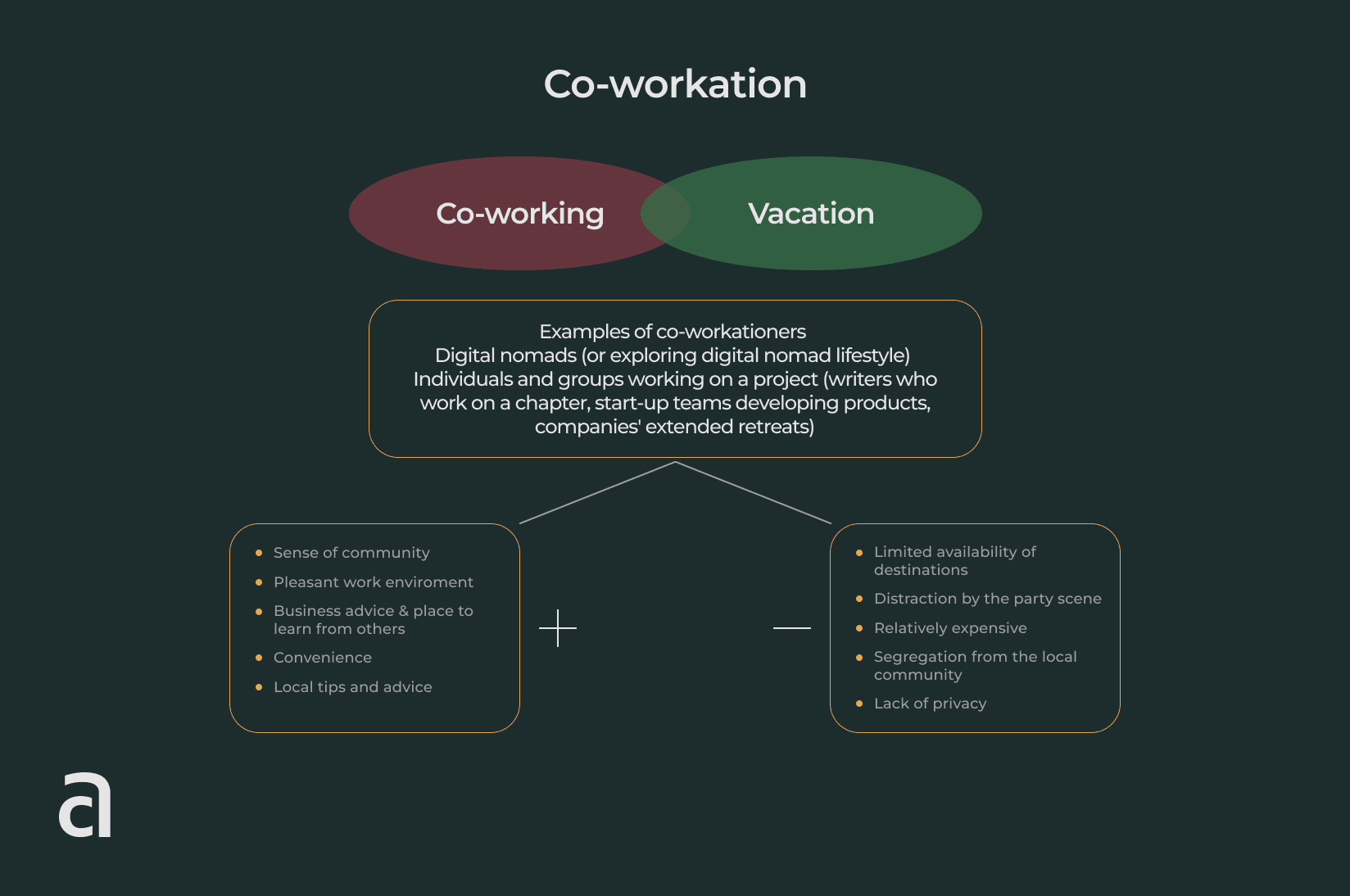
Key features of workation retreats
- Exotic locations: Coworking spaces partner with resorts and lodges in picturesque destinations. Members can work from tropical beaches, mountain chalets, or serene countryside villas.
- Extended stays: Unlike traditional vacations, Workation Retreats offer extended stays, ranging from a few weeks to several months. This allows professionals to immerse themselves in a new environment without sacrificing work commitments.
- Integrated workspaces: These retreats provide fully equipped coworking facilities within the accommodation, ensuring reliable internet, ergonomic workstations, and all necessary amenities.
- Flexible schedules: Participants have the flexibility to choose when and how much they work, enabling them to explore the destination during off-hours. This fosters a healthy work-life balance.
- Wellness programs: Workation Retreats prioritize holistic well-being. They offer yoga and meditation sessions, wellness workshops, and access to fitness centers and spa facilities.
- Cultural immersion: Beyond work, participants engage in cultural activities, local excursions, and immersive experiences, allowing them to connect with the destination's heritage and community.
- Professional networking: These retreats attract diverse professionals from various industries, creating opportunities for networking, collaboration, and idea exchange in a relaxed atmosphere.
- Family-friendly: Some Workation Retreats are family-friendly, accommodating remote-working parents with childcare services, educational activities, and family-oriented outings.
- Personal development: Retreats often include personal development workshops, coaching sessions, and skill-building opportunities to enhance participants' career growth.
- Eco-conscious retreats: A subset of this trend focuses on eco-friendly destinations and sustainable practices, encouraging responsible tourism and environmental conservation.
Workation Retreats reflect the growing desire for experiential work, where professionals can balance productivity with exploration and personal growth. These retreats not only offer a change of scenery but also serve as a source of inspiration, helping individuals rejuvenate and return to their work with renewed creativity and energy.
Conclusions
As we navigate through the evolving landscape of work, the 15 rarely-heard-of trends outlined in this research underscore the innovative, adaptive, and remarkably diverse nature of coworking spaces. From the integration of smart technology to the emergence of industry-specific hubs, these trends not only illuminate the current shifts within the coworking ecosystem but also offer a lens through which we can view the future.
One salient takeaway is the increasing specialization within coworking spaces, which allows them to serve as more than just functional work environments. Whether it's a space designed for digital artists complete with high-speed rendering computers or a biohacker lab equipped with state-of-the-art scientific equipment, these niche spaces show that coworking is no longer a one-size-fits-all solution. Instead, it is rapidly becoming a tailored service adapted to meet the distinct needs of diverse professional groups.
Moreover, the trends highlight how coworking spaces are becoming more deeply integrated into both our professional and personal lives. As these spaces offer amenities that range from child-care services to wellness programs, the line between 'work' and 'life' is increasingly blurred, offering a more holistic approach to productivity and well-being.
Importantly, these trends are more than just ephemeral shifts; they represent substantial opportunities for growth, both for coworking space operators and for the broader ecosystem of startups, freelancers, and corporations. By proactively adapting to these trends, coworking spaces can not only remain competitive but also serve as catalysts for innovation, collaboration, and community-building.
In summary, these 15 rarely-heard-of trends present a roadmap for coworking spaces striving for growth and differentiation in an ever-competitive market. As we move forward, these innovative models and features are set to redefine the way we think about work, collaboration, and community.
So, whether you are a coworking space operator, a potential investor, or simply someone intrigued by the future of work, these trends offer invaluable insights into what lies ahead in the fascinating world of coworking.
References
- https://www.sciencedirect.com/science/article/pii/S0743016723000037
- https://www.emerald.com/insight/content/doi/10.1108/978-1-80455-029-820231004/full/html
- https://journals.openedition.org/cidades/7155
- https://www.mdpi.com/1660-4601/16/13/2379
- https://link.springer.com/chapter/10.1007/978-3-319-62455-6_10
- https://www.sciencedirect.com/science/article/pii/S2444569X22000014
- https://www.mdpi.com/2071-1050/12/24/10547
- https://www.emerald.com/insight/content/doi/10.1108/978-1-80455-029-820231008/full/html
- https://link.springer.com/article/10.1007/s11846-022-00587-9#Sec18
- https://onlinelibrary.wiley.com/doi/full/10.1111/ntwe.12214?saml_referrer
- https://www.tandfonline.com/doi/full/10.1080/10919392.2023.2215666?needAccess=true
- https://dl.acm.org/doi/abs/10.1145/3563357.3566133
- https://firstmonday.org/ojs/index.php/fm/article/download/10598/10000


